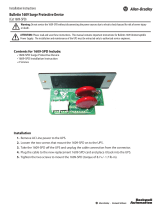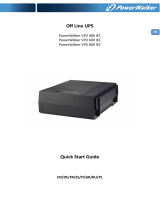Page is loading ...

1
INSTALLATION
Read the safety information sheet before installation.
Unpacking
Inspect the UPS upon receipt. Notify the carrier and dealer if there is damage.
The packaging is recyclable; save it for reuse or dispose of it properly.
Check the package contents:
UPS
Two front bezels
Literature kit containing:
PowerChute
®
Business Edition CD
Bulletin 1609-P Series User Manual CD
1609-NMC (Network Management Card installed in slot located in rear of unit)
Network Management Card CD
Serial cable
Quick Start Guide
Environmental Specifications
TEMPERATURE
O
PERATING
S
TORAGE
32° to 104° F (0° to 40° C)
5° to 113° F (-15 to 45° C) charge UPS battery every six months
MAXIMUM
ELEVATION
O
PERATING
S
TORAGE
10,000 ft (3,000 m)
50,000 ft (15,000 m)
HUMIDITY
0% to 95% relative humidity, non-condensing
This unit is intended for indoor use only.
Select a location sturdy enough to handle
the weight.
Do not operate the UPS where there is
excessive dust or the temperature and
humidity are outside the specified limits.
Ensure the air vents on the front and
rear of the UPS are not blocked.

2
Hardwiring
Wiring must be performed by a qualified electrician.
1. Install a utility circuit breaker in accordance with local electrical codes (see tables below) for input wiring only.
2. Switch the UPS input circuit breaker and utility circuit breakers OFF.
3. Remove the access panel.
4. Remove circular knockouts.
5. Run wires through access panel to terminal blocks. Wire to ground block first. Adhere to all national and local electrical
codes.
6. Use appropriate glands to achieve strain-relief on the hardwired input and output power cables.
Input Connection Output Connection (optional)
Wire to L1, L2, Wire to L1A, L2A,
System Wiring Voltage Current
Full Load
(Nominal)
External Input
Circuit Breaker
(typical)
Wire Size
(typical)
1609-P8000E Input & Output 208/230 V 40 A
220 V 38 A
50 A / 2-pole for
Input Wiring Only
Rockwell part #
1492-MCAA2H50
# 8 AWG
10mm
2
1609-P10000E Input & Output 208/230 V 54 A
220 V 50 A
70 A / 2-pole for
Input Wiring only
Rockwell part #
1492-MCBA2H70
# 6 AWG
16mm
2
7. Switch the circuit breakers ON.
8. Check line voltages.
9. Replace the access panel.

3
Installing and Connecting the Batteries and Attaching the Front Bezel
n o
p q
r s

4
Connecting Power and Equipment to the UPS
1. Hardwire the UPS (see Hardwiring).
2. Connect equipment to the UPS.
3. Turn on all connected equipment. To use the UPS as a master on/off switch, be sure that all connected equipment is
switched ON.
4. Press the
button on the front panel to power up the UPS.
• The battery charges to 90% capacity during the first three hours of normal operation.
• Do not expect full battery run capability during this initial charge period.
B
ASIC CONNECTORS
Serial port
Power management software and interface cable can be used with the UPS.
Use only a supplied or approved interface cable.
Any other serial interface cable will be incompatible with the UPS connector.
EPO Terminal
The optional Emergency Power Off (EPO) feature allows connected loads to be immediately de-
energized from a remote location, without switching to battery operation (see EPO Option).
TVSS Screw
The UPS features a transient voltage surge-suppression (TVSS) screw for connecting the ground
lead on surge suppression devices such as telephone and network line protectors.
When connecting grounding cable, disconnect the unit from the utility power outlet.
external battery pack
connectors
Optional external battery packs provide extended runtime during power outages. These units
support up to 10 external battery packs.

5
OPERATION
FRONT DISPLAY PANEL
Indicator Description
Online
The UPS is drawing utility power and performing double conversion to supply power to connected equipment
(see Troubleshooting).
On Battery
The UPS is supplying battery power to the connected equipment.
Bypass
The UPS is in bypass mode, sending utility power directly to connected equipment.
Bypass mode operation is the result of an internal UPS fault, an overload condition or a user initiated command
either through an accessory or the manual bypass switch. Battery operation is not available while the UPS is in
bypass mode (see Troubleshooting).
Fault
The UPS detects an internal fault (see Troubleshooting).
Overload
The connected loads are drawing more power than the UPS power rating (see Troubleshooting).
Replace
Battery
The battery is disconnected or must be replaced (see Troubleshooting).
Feature Function
Power On
Press this button to turn on the UPS. (Read on for additional capabilities.)
Power Off
Press this button to turn off the UPS.
Normal /
Bypass
Manually switch connected equipment to bypass mode, so that utility power is sent directly to connected
equipment. Battery operation is not available while the UPS is in bypass mode. (See Troubleshooting.)
Cold Start
This is not a normal condition.
Supply immediate battery power to the UPS and connected equipment (see Troubleshooting). Press and hold
the
button to power up the UPS and connected equipment. The UPS will emit two beeps. During the
second beep, release the button.
Self-Test
Automatic: The UPS performs a self-test automatically when turned on, and every two weeks thereafter (by
default). During the self-test, the UPS briefly operates the connected equipment on battery.
Manual: Press and hold the
button for a few seconds to initiate the self-test.

6
USER CONFIGURABLE ITEMS
NOTE: SETTINGS ARE MADE THROUGH SUPPLIED POWERCHUTE SOFTWARE,
OPTIONAL NETWORK MANAGEMENT CARDS, OR TERMINAL MODE.
FUNCTION
F
ACTORY
D
EFAULT
U
SER SELECTABLE
CHOICES
DESCRIPTION
Automatic Self-Test Every 14 days
(336 hours)
Every 7 days
(168 hours),
Every 14 days
(336 hours),
On Startup Only,
No Self-Test
Set the interval at which the UPS will execute
a self-test.
UPS ID UPS_IDEN Up to eight characters to
define the UPS
Uniquely identify the UPS, (i.e. server name
or location) for network management
purposes.
Date of Last Battery Replacement Manufacture Date mm/dd/yy Reset this date when you replace the battery
modules.
Minimum Capacity Before Return
from Shutdown
0 percent 0, 15, 25, 35, 50, 60, 75,
90 percent
Specify the percentage to which batteries will
be charged following a low-battery shutdown
before powering connected equipment.
Alarm Delay After
Line Failure
5 second delay 5 second delay,
30 second delay,
At Low Battery,
Never
Mute ongoing alarms or disable all alarms
permanently.
Shutdown Delay 20 seconds 0, 20, 60, 120, 240, 480,
720, 960 seconds
Set the interval between the time when the
UPS receives a shutdown command and the
actual shutdown.
Duration of
Low Battery Warning.
2 minutes
PowerChute
software provides
automatic,
unattended
shutdown when
approximately two
minutes of battery
runtime remains.
2, 5, 7, 10, 12, 15, 18,
20 minutes.
The low battery warning beeps become
continuous when two minutes of runtime
remains.
Change the warning interval to a higher setting
if the operating system requires a longer
interval for shutdown.
Synchronized Turn-on Delay 0 seconds 0, 20, 60, 120, 240, 480,
720, 960 seconds
Specify the time the UPS will wait after the
return of utility power before turn-on (to avoid
branch circuit overloads).
High Bypass Point
+10% of
output voltage
setting
+5%, +10%, +15%,
+20%
Maximum voltage that the UPS will pass to
connected equipment during internal bypass
operation.
Low Bypass Point -30% of output
voltage setting
-15%, -20%, -25%, -30% Minimum voltage that the UPS will pass to
connected equipment during internal bypass
operation.
Output Voltage 208/230 V models:
230 VAC
208/230 V models:
200, 208, 220,
230, 240 VAC
Allows the user to select the UPS output
voltage while online.
Output Frequency Automatic
50 ± 3 Hz or
60 ± 3 Hz
50 ± 3 Hz,
50 ± 0.1 Hz
60 ± 3 Hz
60 ± 0.1 Hz
Sets the allowable UPS output frequency.
Whenever possible, the output frequency
tracks the input frequency.
Number of Battery Packs 1 Number of Connected
Batteries (four battery
modules per pack)
Defines the number of connected battery packs
for proper runtime prediction.

7
EPO (Emergency Power Off) Option
The output power can be disabled in an emergency by closing a switch connected to the EPO.
Adhere to national and local electrical codes when wiring.
Rockwell Automation recommends Allen-Bradley Catalog Number 800F Emergency Stop Operator as the interface to the EPO
to connector.
The switch should be connected in a normally open switch contact. External voltage is not required; the switch is driven by
12 V internal supply. In closed condition, 2m A of current are drawn.
The EPO switch is internally powered by the UPS for use with non-powered switch circuit breakers.
The EPO circuit is considered a Class 2 circuit, (UL, CSA standards) and an SELV circuit (IEC standard).
Both Class 2 and SELV circuits must be isolated from all primary circuitry. Do not connect any circuit to the EPO terminal
block unless it can be confirmed that the circuit is Class 2 or SELV.
If circuit standard cannot be confirmed, use a contact closure switch.
Use one of the following cable types to connect the UPS to the EPO switch:
• CL2: Class 2 cable for general use.
• CL2P: Plenum cable for use in ducts, plenums, and other spaces used for environmental air.
• CL2R: Riser cable for use in a vertical run in a floor-to-floor shaft.
• CLEX: Limited use cable for use in dwellings and for use in raceways.
• For installation in Canada: Use only CSA certified, type ELC (extra-low voltage control cable).
• For installation in other countries: Use standard low-voltage cable in accordance with local regulations.
MAINTENANCE AND TROUBLESHOOTING
Installing and Replacing the Battery Module(s)
This UPS has easy to replace, hot-swappable battery modules. Replacement is a safe procedure, isolated from electrical hazards.
You may leave the UPS and connected equipment on during the procedure.
Refer to the Bulletin 1609-P UPS Information CD for more details.
Troubleshooting
Refer to the user manual on the Bulletin 1609-P UPS Information CD for details.
Allen-Bradley Company, LLC
Industrial Components Business
1201 South Second Street
Milwaukee, WI 53204-2496 USA
Phone 440.646.5800
www.ab.com
41063-258-01 (1)
/


